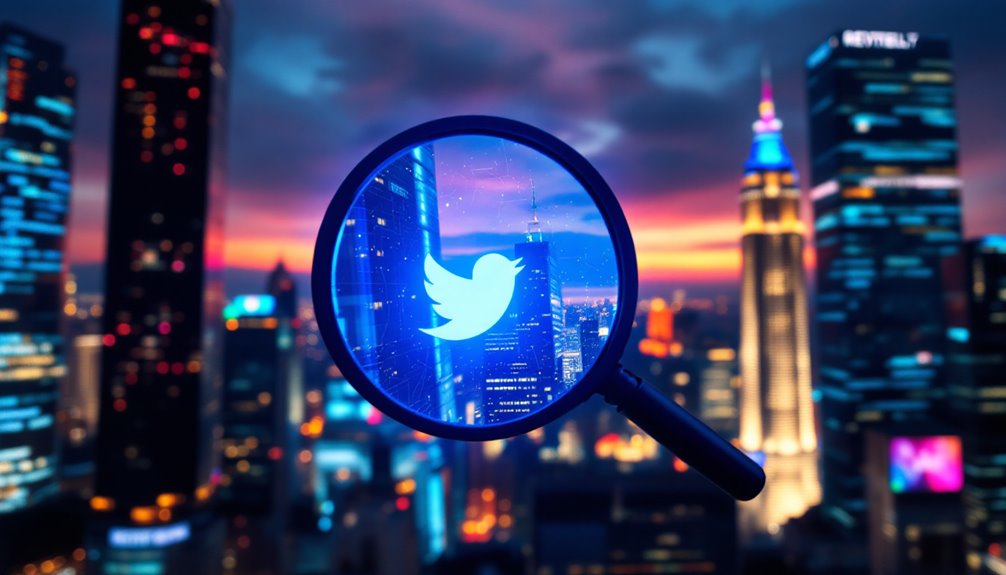
Who sees retweets?
You might not realize that when someone retweets your post, it can potentially be seen by people who don’t follow either of you. This magic happens through interactions and the mysterious workings of the Twitter algorithm. Ever wondered how your tweet’s visibility extends beyond your own network? You’ll want to understand the dynamics of retweets and how engagement metrics play a role in amplifying your message. Consider how media content, privacy settings, and trending topics can further influence who sees your retweeted content. Curious about maximizing your tweet’s reach? Let’s explore how retweets can impact your online presence.
Key Takeaways
- Followers of the account retweeting see the retweet in their timelines.
- Retweets can reach users who follow hashtags included in the tweet.
- Users engaging with similar content may see retweets due to algorithmic suggestions.
- Public retweets are visible to anyone who views the profile of the retweeting account.
- Retweets can appear in the “Explore” section if they gain significant engagement.
Understanding Tweet Visibility

Tweet visibility on Twitter is often determined by several key factors that dictate how your content is perceived and shared. The algorithm places a significant emphasis on engagement metrics. When your tweets garner likes, retweets, and replies, it signals to the platform that your content holds value and relevance. This, in turn, enhances your tweet reach by exposing it to a broader audience. Every reply amplifies this effect, further boosting your content’s distribution score.
Recency is another critical component, especially given Twitter’s real-time nature. Fresh tweets, particularly those tied to breaking news or live events, enjoy heightened visibility. This guarantees that users are consistently updated with the latest information, making timely content a strategic asset for maximizing reach.
The type of content you share also influences visibility. Rich media such as images, videos, and GIFs typically receive more engagement, which naturally increases tweet reach. Interactive elements like polls can further enhance this effect. Utilizing hashtags and trending topics can further expand your tweet’s reach by integrating it with ongoing conversations, enhancing brand visibility.
Finally, author credibility and the relationship between users play a pivotal role. Verified accounts with a solid reputation and consistent interaction history are favored, guaranteeing that well-regarded voices are more prominently heard in the Twitterverse.
Impact of Retweets
Understanding tweet visibility sets the stage for exploring how retweets specifically amplify your content’s reach. By employing effective retweet strategies, you can notably boost your tweet’s exposure to a broader audience, extending beyond just your followers.
When your tweet is retweeted, it reaches new followers of the user who shared it, magnifying your message’s reach exponentially. This expanded network introduces your content to users who may not have encountered your original tweet, enhancing overall audience engagement.
Data shows that retweets increase visibility by up to 20 times compared to tweets without them. By incorporating images or videos, you can double this visibility, creating a compelling retweet strategy. It’s important to note that likes can increase tweet visibility by 30 times, further emphasizing the significance of engagement strategies.
As retweets extend a tweet’s lifespan beyond the typical 18 minutes, they guarantee your message remains part of ongoing conversations or trending topics, further enhancing visibility.
Tracking retweets over time allows you to analyze engagement trends and refine your strategies for maximum impact. The average tweet garners approximately 1690.46 retweets, highlighting the potential for notably increased engagement.
The Twitter Algorithm

To understand who sees retweets, you need to grasp how the Twitter algorithm ranks and prioritizes content. The algorithm uses engagement metrics such as likes, retweets, and replies to assign weights, heavily influencing a tweet’s visibility. This system not only highlights the significance of user interactions but also underscores how recent and engaging content can expand your tweet’s reach. The algorithm processes approximately 500 million Tweets daily to curate top content, ensuring that the most relevant and engaging posts are surfaced to users.
Ranking Factors Explained
Delving into the mechanics of Twitter’s algorithm, one discovers how user behavior, tweet characteristics, recency, and network context shape the visibility of tweets on your timeline.
Understanding these ranking factors can refine your retweet strategies and enhance audience targeting. Tweets from accounts you follow are prioritized, especially if you’ve previously interacted with them through replies, likes, or retweets. Visiting an author’s profile or spending time on their tweets further increases their visibility. The algorithm is designed to balance content from diverse authors and perspectives while excluding blocked accounts and NSFW content.
Tweet characteristics greatly influence ranking. Media content, like images and videos, provides a 2x boost, while language consistency with your followers offers a 1.1x advantage. However, using multiple hashtags incurs a 40% penalty, and poor spelling is penalized by 95%.
Trending topics also receive a modest 1.1x boost, making them a strategic target for gaining visibility.
Recency and virality are essential; the algorithm favors recent, engaging content. Tweets that drive conversations or relate to current events are deemed valuable.
In addition, network context, such as interactions with similar users or content, and the “RealGraph” score, which predicts user interaction likelihood, play important roles in tweet prioritization.
Understanding these elements allows you to optimize your presence strategically.
Engagement’s Impact
In the domain of Twitter’s algorithm, engagement metrics wield considerable influence over tweet visibility. Engagement types such as likes, retweets, and replies serve as powerful signals to the algorithm, indicating content relevance and popularity. A like can amplify a tweet’s reach by 30 times, while a retweet boosts it by 20 times. These interactions signal user interest, prompting the algorithm to prioritize such content, thereby expanding its audience.
Interacting with engaging and current content enhances its visibility. For instance, participating in popular discussions or using trending hashtags can markedly increase a tweet’s reach. Including media elements like images or videos can further enhance engagement and visibility. Consistent posting and tapping into topical themes can build anticipation, effectively increasing interaction rates. Tweets that incorporate rich media, such as videos and GIFs, tend to generate more engagement, as they capture attention and encourage interaction.
The algorithm also responds dynamically to user behaviors. Spending more time on a tweet or engaging with it through replies can skyrocket its visibility—by 22 times for time spent and 54 times for responding.
However, engagement must be positive; negative actions like reporting can drastically reduce a tweet’s reach. Balancing your follower-following ratio and maintaining credibility are essential for keeping tweets visible while avoiding disinformation safeguards your content from diminished reach.
Engagement Metrics
Engagement metrics are vital for understanding how your Twitter content resonates with the audience. By leveraging engagement strategies and metrics analysis, you can optimize your content to reach wider audiences and drive meaningful interactions. Monitoring metrics reveals best posting times and effective hashtags, essential for achieving Twitter marketing goals and informed decision-making.
Here’s a breakdown of key engagement types to evaluate:
- Likes: They show appreciation and signal that your content is hitting the mark with your audience.
- Retweets: Important for expanding your tweet’s reach, as they push your content onto new timelines, introducing it to users who don’t follow you.
- Replies: Indicate deeper engagement, where users take the time to interact, providing valuable insights into audience sentiment.
- Link Clicks: These are essential for driving traffic, whether to external sites, hashtags, or embedded media, highlighting areas where users seek more information.
Calculating engagement rates helps refine content strategies by quantifying the effectiveness of your tweets. This metric is derived by dividing total engagements by impressions, then multiplying by 100.
Comparing these rates against historical data or industry averages offers insights into your performance trajectory. Tools like Socialinsider and Metricool can facilitate thorough metrics analysis, enabling you to track trends and adjust strategies dynamically.
User Interaction Effects

Understanding how users interact with your content on Twitter extends beyond basic engagement metrics, shedding light on the dynamics of user interaction effects. Retweet motivation is driven by several factors that enhance user engagement and can greatly amplify your tweet’s visibility. For instance, users are more inclined to retweet when they notice a tweet already gaining traction, evidenced by previous retweets. This behavior underscores the importance of crafting content that naturally attracts initial engagement, such as including mentions, hashtags, or URLs. These elements not only make your tweets more retweetable but also increase their reach by tapping into broader network layers. Additionally, 77% of Twitter users interacted with a promoted tweet, highlighting the significant potential for content that resonates with a wider audience. Moreover, user engagement patterns reveal a strong correlation between prior interactions and retweet likelihood. If a user has interacted with your tweets before, they’re more likely to do so again, particularly if your content aligns with their interests and timing. The age of a tweet and the sender’s activity level are critical in predicting retweet probability. Innovative strategies, such as leveraging multilayer network effects, can further enhance retweet predictions by integrating data from different interaction types like follow or reply.
Follower Dynamics
Understanding follower dynamics requires examining the balance between follower accumulation and engagement. Data indicates that a balanced follower ratio, where followers are both numerous and actively engaged, greatly enhances retweet visibility. Engaged followers amplify reach through their interactions, which influences how often and widely your retweets are seen. Additionally, the X algorithm curates feeds based on user interactions, prioritizing tweets for relevance and engagement potential.
Balanced Follower Ratio
Grasping the nuances of a balanced follower ratio on Twitter is crucial for enhancing your social media influence and growth. A well-managed ratio can markedly impact follower growth and inform your engagement strategies. The follower ratio is the proportion between the number of followers you have and the number of accounts you follow. Striking a balance here is critical for several reasons:
- Enhancing Influence: A higher follower-to-following ratio often signals greater social media influence, boosting your credibility.
- Managing Limits: Twitter sets limits once you follow 5,000 accounts, requiring a balanced ratio to continue expanding your network. Following too many can imply a lack of valuable content, so keeping this balance is essential.
- Facilitating Engagement: Maintaining a balanced ratio can lead to increased engagement, as it reflects reciprocal relationships and active interactions.
- Optimizing Growth: Regularly reviewing and adjusting your follow list guarantees that your ratio remains healthy, supporting sustainable follower growth.
For accounts with fewer than 5,000 followers, aim for a ratio between 0.75 and 1.25. Once you surpass this threshold, maintaining a ratio above 1.0 becomes more feasible and beneficial.
Monitoring this ratio helps you understand your platform standing and refine your approach to maximize reach and influence.
Engaged Follower Impact
Balancing your follower ratio sets the stage for understanding the profound impact engaged followers can have on your Twitter presence. Engaged followers drive the success of your engagement strategies by actively participating in retweeting and replying to your content. This activity not only indicates content value but also fosters follower loyalty.
When your tweets resonate, they’re retweeted and spread rapidly, often reaching an average of 1,000 users, amplifying your message beyond your immediate follower count. Twitter Analytics offers insights into post performance and audience engagement, though access is restricted to premium users.
The engagement rate, calculated by dividing total engagements by impressions or followers, offers actionable insights into your content’s effectiveness. High retweet rates serve as a key performance indicator, signaling how well your content resonates and influences brand perception.
By analyzing these metrics, you can refine your content strategies, determining the best posting times to maximize reach and interaction.
Retweets don’t just signify popularity; they reflect your influence within specific topics. Since influence can vary, leveraging top influencers in your niche can enhance your marketing strategy, given their disproportionate retweet rates.
Understanding this dynamic fosters innovation in how you engage your audience, ensuring your Twitter presence remains impactful and relevant.
Role of Media Content

Harnessing the power of media content in tweets can greatly elevate their reach and visibility. By strategically incorporating various media types, such as images, GIFs, and videos, you can markedly enhance user engagement. This isn’t just about adding flair; it’s about crafting content strategies that align with Twitter’s algorithm, which favors rich media. Effective Twitter strategies require more than just access to data; they need analysis and understanding to optimize how consumer-generated content influences visibility and engagement.
When your tweets engage users, they organically signal to the algorithm to boost your content’s visibility, making them more likely to appear in timelines and search results.
- Engagement Boost: Rich media like images and videos encourage users to interact more than text-only posts. This interaction increases the likelihood of your tweet being shared and seen by a wider audience.
- Algorithm Favoritism: The algorithm prioritizes tweets with rich media. By using these media types, your content is more likely to be prioritized in user timelines, enhancing reach.
- Strategic Reach: Retweeted rich media content exposes your brand to new audiences, expanding beyond your initial follower count.
- User Interaction: Rich media fosters higher likes, retweets, and replies, which build trust and credibility, acting as a powerful endorsement for your brand.
Account Settings Influence
Your account settings greatly impact who can view and retweet your content.
With public accounts, your tweets are accessible to anyone, enhancing visibility and shareability, while protected accounts limit retweets to approved followers, ensuring controlled exposure.
Additionally, turning off retweets from specific accounts provides further customization over your timeline, allowing you to manage which content circulates within your network. To further tailor your experience, you can mute retweets on an individual basis, but note that there is no bulk option available for muting all retweets at once.
Privacy Settings Impact
When managing your Twitter account, understanding the impact of privacy settings on retweets is essential. Your choice between public and private settings carries significant privacy implications and retweet restrictions.
Public accounts allow anyone on the Internet to view and retweet your tweets, making your content accessible and searchable by all users. In contrast, private accounts restrict tweet visibility and retweet ability to approved followers, safeguarding your content from prying eyes. Protected accounts are indicated by a lock icon next to user names, ensuring that only followers you approve can interact with your tweets.
Consider these key points:
- Public Account Benefits: With public settings, your tweets can gain widespread reach, increasing retweet potential, especially if they include URLs and hashtags. However, this openness means anyone can access your content without needing approval.
- Private Account Protection: Only approved followers can see your tweets and retweets, providing a layer of privacy. Non-followers remain blocked from viewing your profile or tweets, minimizing unwanted exposure.
- Change Implications: Switching from private to public makes all previous tweets publicly accessible. To manage privacy, delete sensitive tweets before altering settings.
- Retweet Dynamics: Public tweets are more likely to be retweeted quickly, with over 50% of retweets occurring within the first hour of posting.
Retweet Visibility Control
Understanding how individual account settings influence retweet visibility empowers you to tailor your Twitter experience. By customizing retweet preferences, you can control the content you see on your timeline, enhancing both relevance and engagement.
The ability to mute retweets from specific accounts gives you the power to refine your feed with precision. Simply navigate to the desired profile, tap the three-dot or gear icon, and select “Turn off Retweets.” This visibility customization guarantees only original tweets from that account populate your timeline, while retweets from other accounts remain unaffected unless muted individually. Turning off retweets can reduce clutter in your news feed, allowing for a more streamlined viewing experience.
The impact on your timeline is significant; turning off retweets from a particular account streamlines your feed, focusing on original content. This customization is consistently available across Android, iOS, and desktop, with changes applied universally across all platforms. Such uniformity guarantees a seamless user experience regardless of your device.
Moreover, the flexibility of these settings allows you to reverse changes effortlessly. By following the same steps, you can re-enable retweets at any time, guaranteeing no data loss or permanent alterations.
This adaptability in retweet visibility control aligns with an innovative approach to managing your online presence.
Tools for Visibility

The digital landscape is a bustling marketplace where visibility is key, and automated retweeting tools are the unsung heroes that can amplify your Twitter presence.
These tools automatically search for content based on criteria like keywords and hashtags, sharing it instantly or on a schedule. This increases tweet visibility and engagement without manual intervention. Twitter’s average tweet lifespan is only 18 minutes, making timely retweets crucial for maintaining visibility and relevance in fast-moving conversations.
Hybrid tools merge manual selection with automation, giving you control while saving time. This balance can help you build relationships with followers by engaging with their content more effectively.
Consider these features for increasing visibility:
- Automated Retweeting: Boosts engagement by sharing content that aligns with your brand, using criteria like hashtags or user accounts.
- Hybrid Tools: Combine manual and automated functions, offering flexibility for targeted sharing and maintaining control over your social media presence.
- Popular Free Tools: Platforms like TweetDeck and Hootsuite allow for scheduling and monitoring, providing analytics to track and adjust strategies.
- Advanced Features: Tools such as Tweepi and Followerwonk help identify and engage with relevant users, enhancing your credibility and authority through consistent, valuable content sharing.
Embracing these tools lets you optimize your Twitter strategy, reaching a broader audience with precision and efficiency.
Privacy and Sharing
In today’s interconnected world, privacy and sharing on Twitter require careful consideration to manage your online presence effectively. Understanding tweet privacy and sharing options is essential. By default, Twitter accounts are public, allowing anyone to view and retweet your tweets, which are accessible globally on the internet. This openness promotes engagement but requires awareness of what you share.
If you desire more control over who sees your content, switching to a protected account is an option. Protected accounts limit visibility to approved followers only, ensuring your tweets aren’t retweeted beyond this circle. It’s important to note that with a private account, non-followers cannot see profile details or tweets, providing an additional layer of privacy.
When it comes to sharing options, retweet restrictions play a significant role. Although you can’t globally disable retweets, you can individually manage them. By selecting “Turn off Retweets” for specific users, you hide their retweets from your timeline, tailoring your feed to fit your preferences.
Adjusting privacy settings is straightforward through the “Settings and Privacy” menu, where you can enable “Protect your Tweets” under “Audience and tagging.” Remember, changing from protected to public makes past tweets visible to everyone.
















